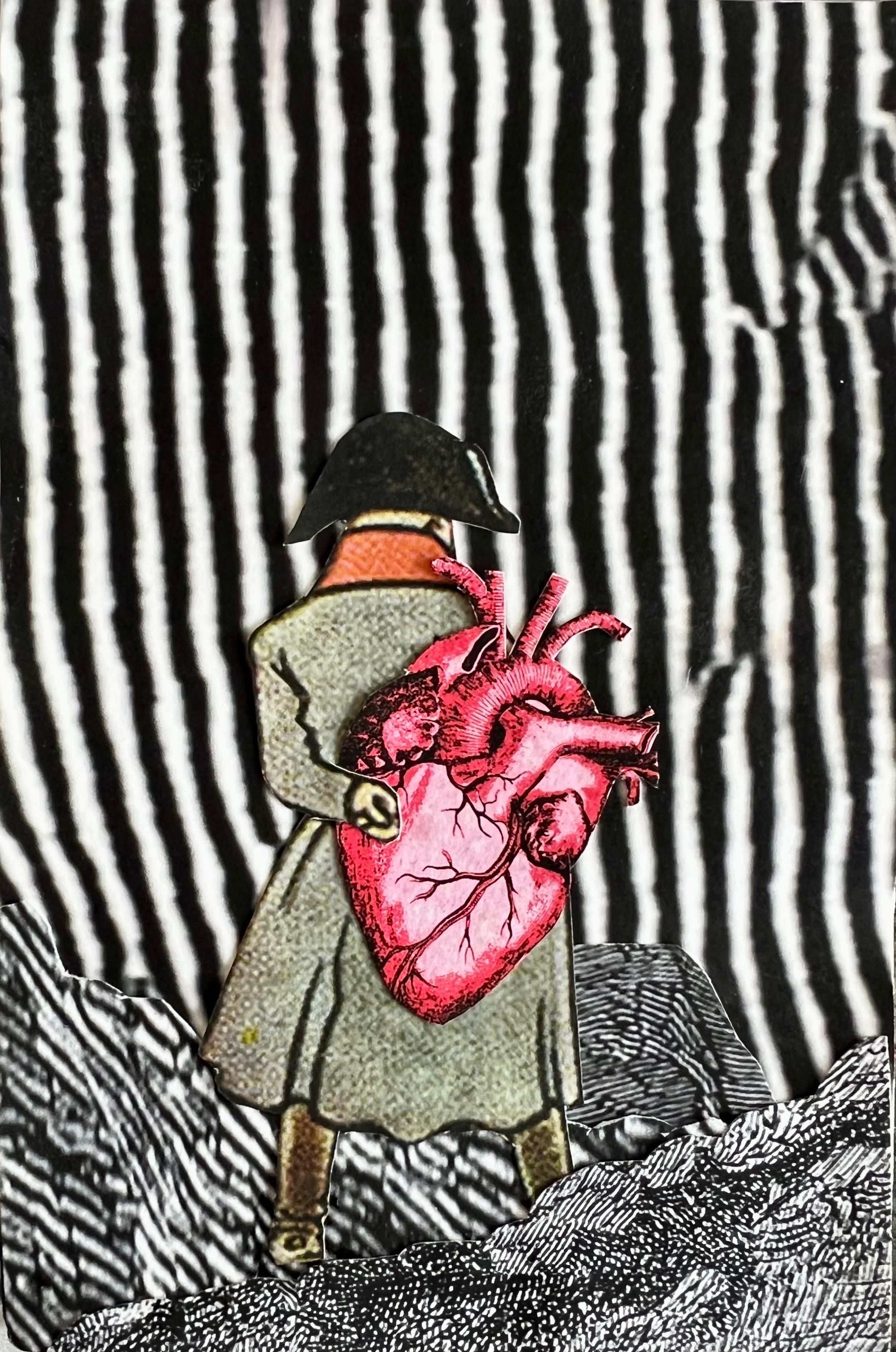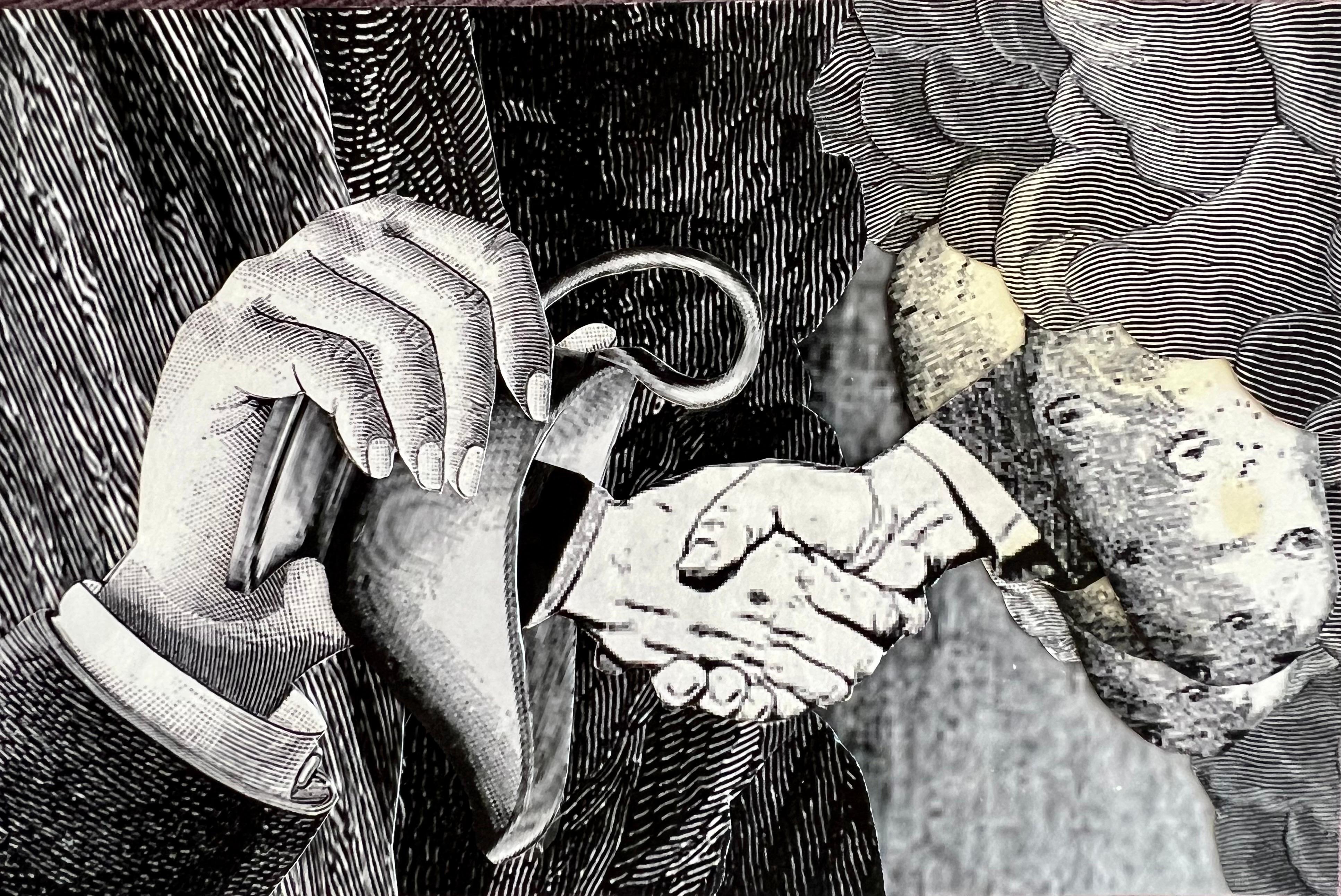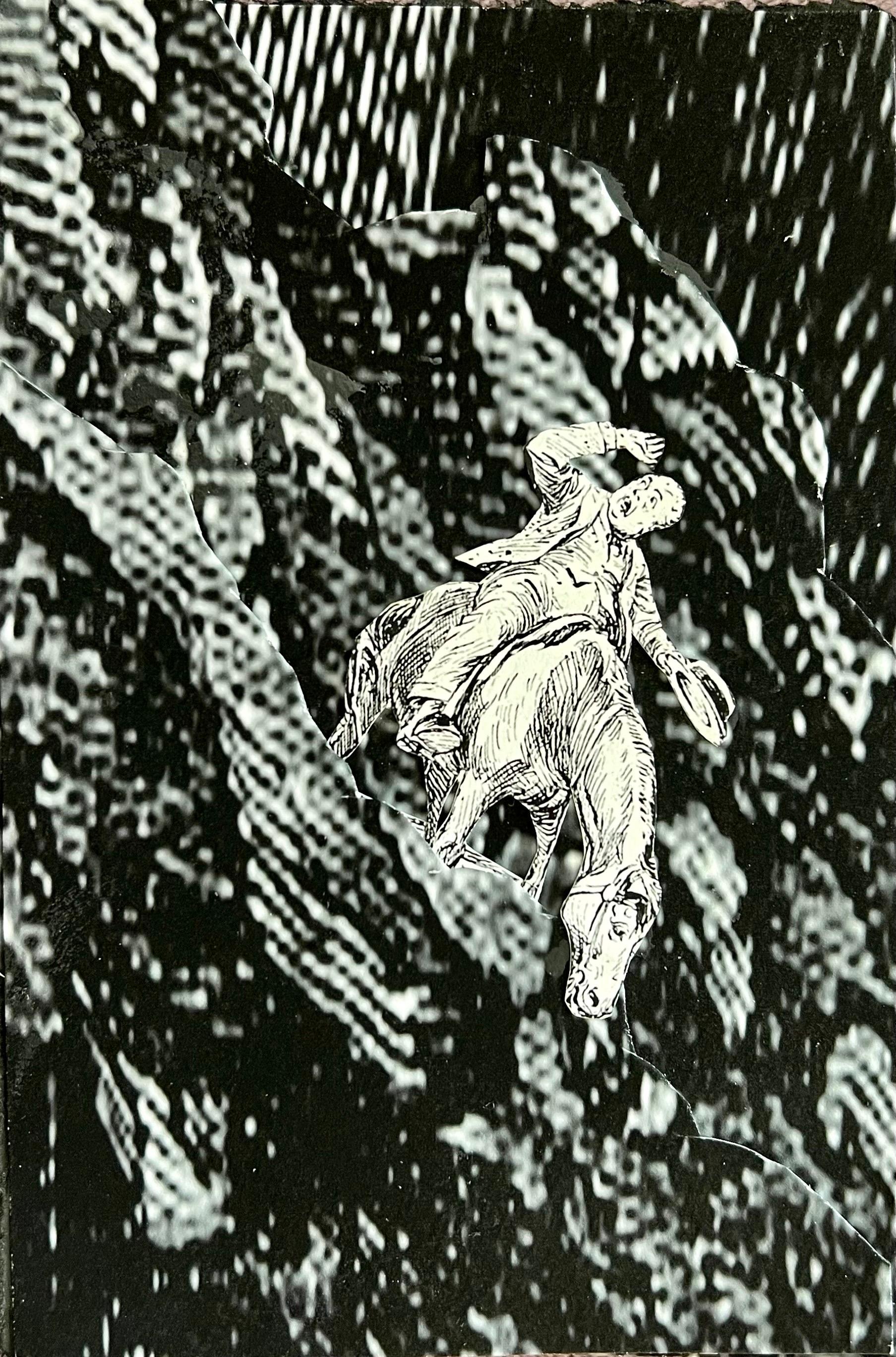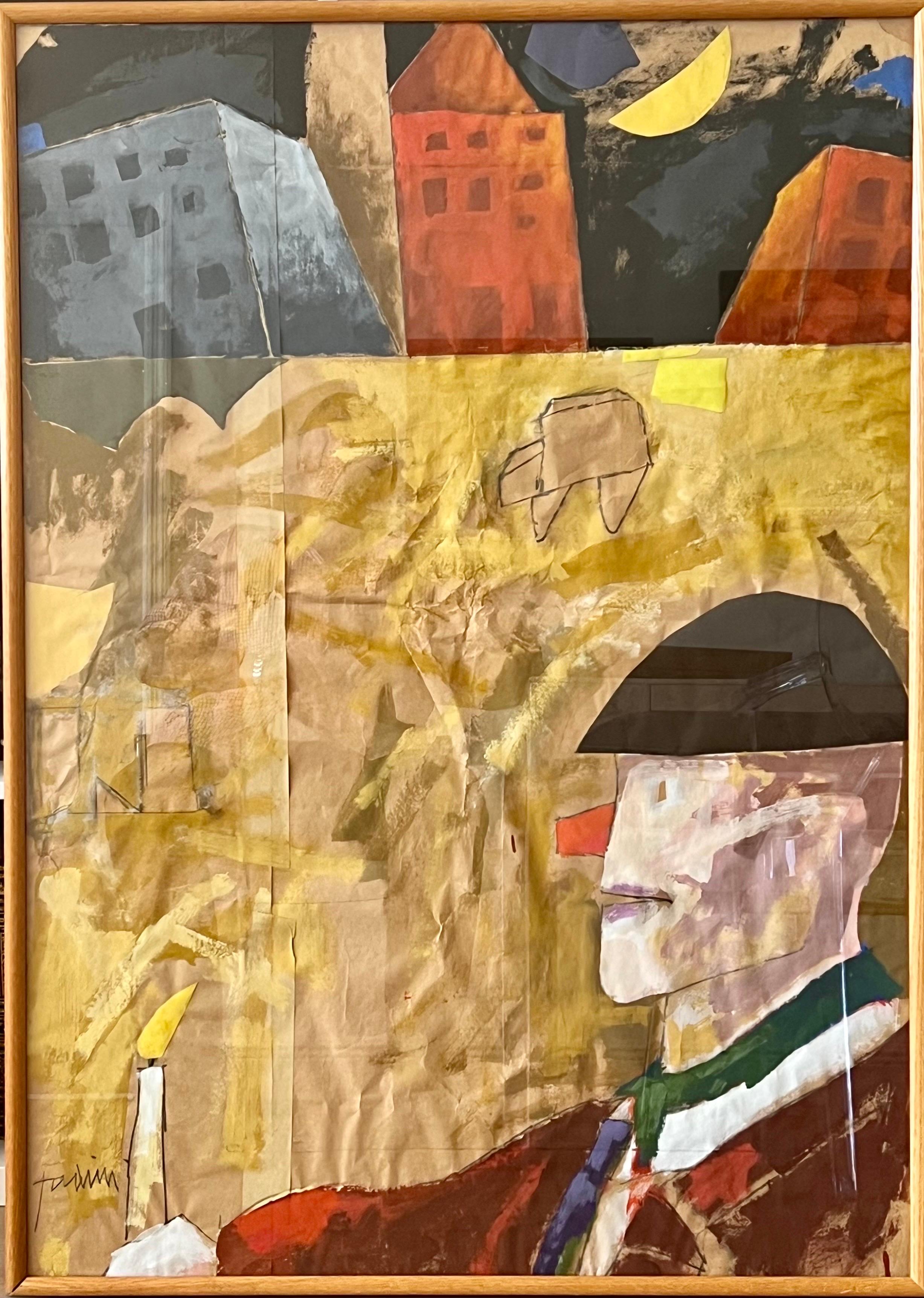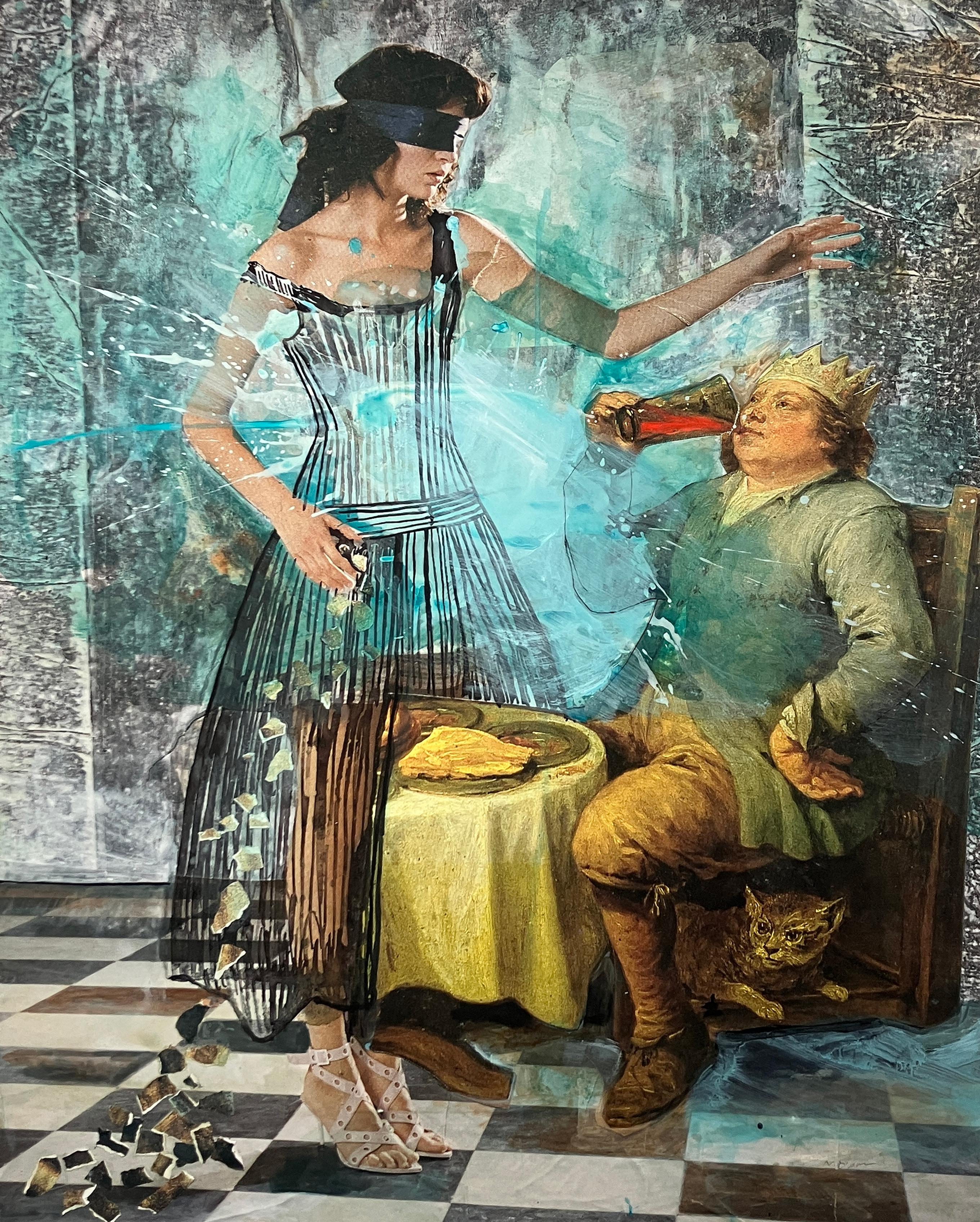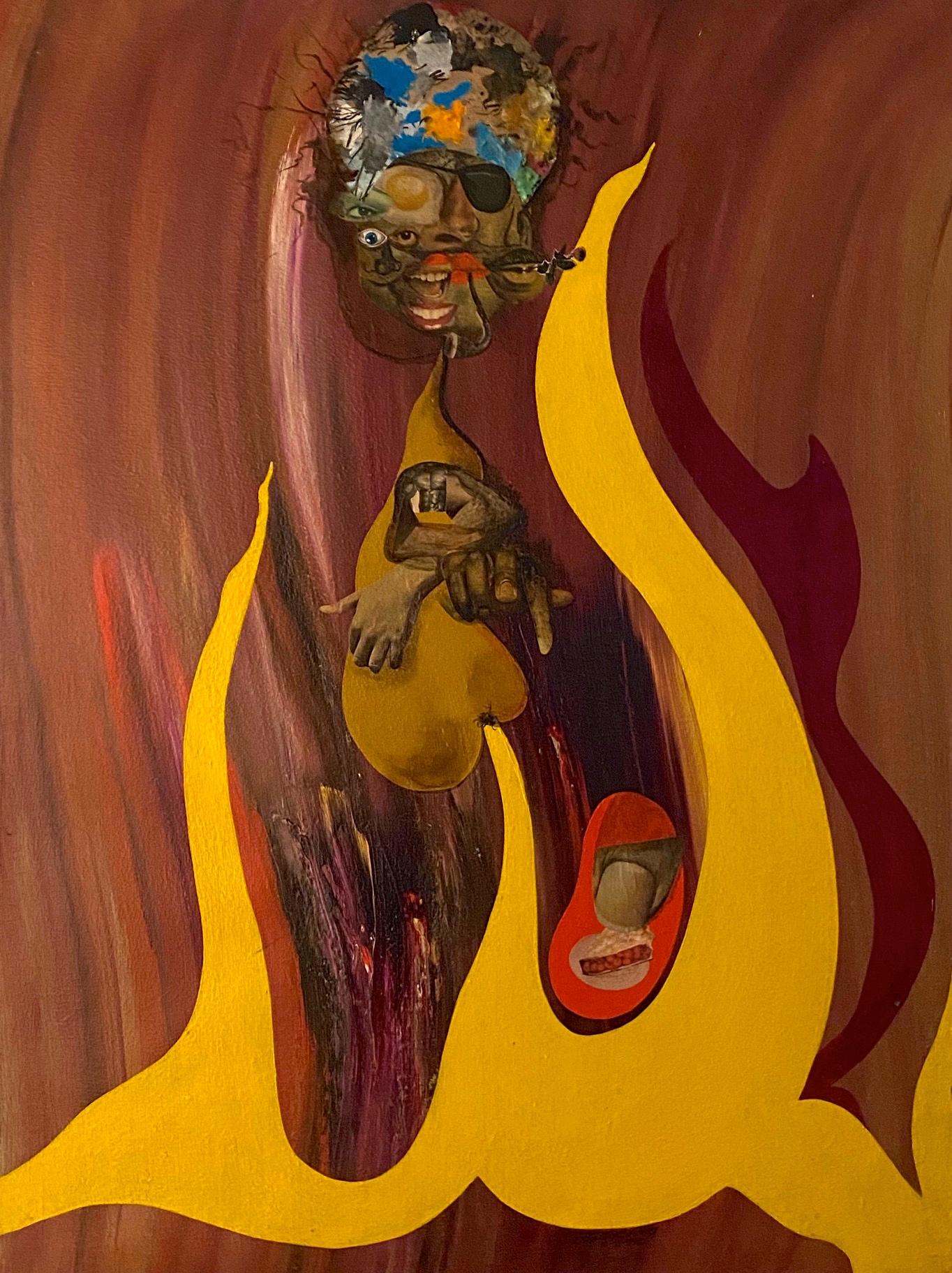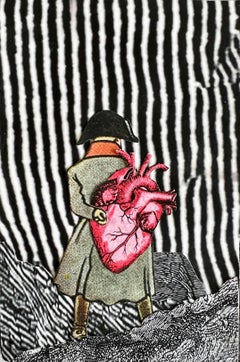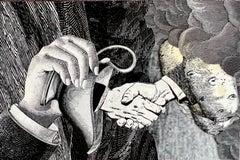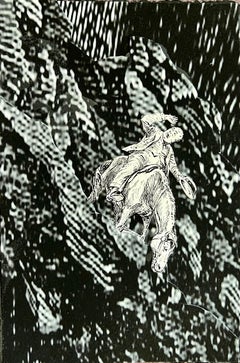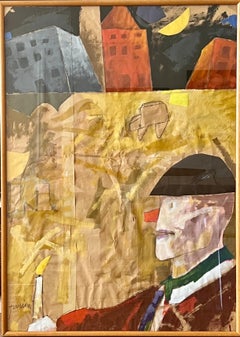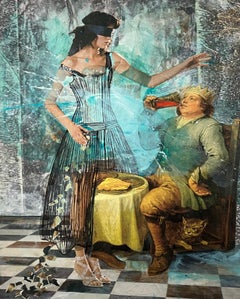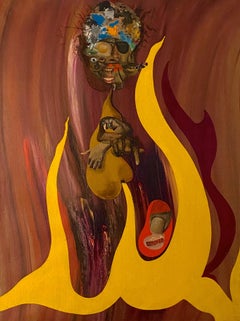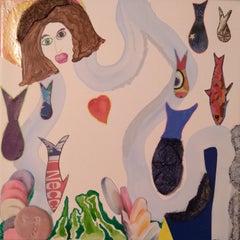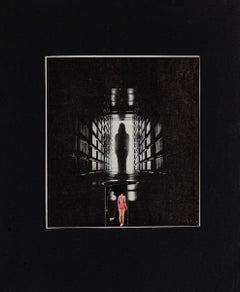Items Similar to Collage Watercolor Painting David Gilhooly California Funk Surrealism MixedMedia
Want more images or videos?
Request additional images or videos from the seller
1 of 7
David GilhoolyCollage Watercolor Painting David Gilhooly California Funk Surrealism MixedMedia2013
2013
$500
£382.59
€437.88
CA$706.13
A$767.44
CHF 411.28
MX$9,318.13
NOK 5,163.37
SEK 4,788.24
DKK 3,270.44
About the Item
DAVID JAMES GILHOOLY (American, 1943-2013),
Mixed media collage
6 x 4 inches,
Hand signed and dated verso
Napoleon from the back, with King Henry VIII holding a pastry.
titled: "England cannot be conquered by a few French pastries"
cut and pasted cardstock assemblage, collaged art.
David Gilhooly RCA (1943 – 2013), was an American ceramicist, sculptor, painter, printmaker, and professor. He is best known for pioneering the Funk art movement. He made a series of ceramic frogs called FrogWorld, as well as ceramic food, planets, and other creatures.
David James Gilhooly III was born on April 15, 1943, in Auburn, California. He was raised in Los Altos, California; Saint Croix in the Virgin Islands; and Humacao, Puerto Rico.
He enrolled in University of California, Davis (UC Davis) initially studying biology, followed by anthropology, and ending with a focus on fine art. While attending UC Davis, Gilhooly served as artist Robert Arneson assistant starting in 1963. He graduated from UC Davis with a BA degree in 1965, and an MA degree in 1967.
Gilhooly, together with Robert Arneson, Peter Vandenberge, Chris Unterseher, and Margaret Dodd, working together in TB-9 (temporary building 9) were what was later to be called, The Funk Ceramic Movement of the San Francisco Bay Area. Inspired by Abstract Expressionism and the sculptures of Claes Oldenburg, Gilhooly produced sculptures with comical, surrealist, subject matter including food, animals, plants, and a series centered on frogs. David left TB-9 for one semester to become Manuel Neri's assistant and started making art out of lumber, fur, neon lights and asbestos shingles.
He has worked in many media including furniture, painting, drawing and bronze, porcelain, ceramic and clay sculpture.
From 1967 to 1969, Gilhooly taught at San Jose State University (SJSU). In 1969, Gilhooly met ceramicist Victor Cicansky at UC Davis and, at his suggestion, he took a teaching position at the University of Saskatchewan in Canada (1969 to 1971). He followed this with seven years at York University, in Toronto, Canada.
He was a member of the Royal Canadian Academy of Arts.
Work
Gilhooly created clay objects that are satirical takes on contemporary life. Works such as his Victoria. Bathing with the Beavers (Art Gallery of Nova Scotia), might contain imperfections to mimic hobby work.
Collections
Public art collections holding works by David Gilhooly including the Art Gallery of Nova Scotia; Arizona State University Art Collections (Tempe, Arizona); the Fine Arts Museums of San Francisco; the Art Institute of Chicago; the Honolulu Museum of Art; the Jane Voorhees Zimmerli Art Museum at Rutgers University; the Little Rock Art Center (Little Rock, Arkansas); the Louisiana State University (Baton Rouge, Louisiana); the National Gallery of Canada; the Norton Museum of Art; the Oakland Museum of California; the Palm Springs Desert Museum; the Philadelphia Museum of Art; the San Antonio Museum of Art; the San Francisco Museum of Modern Art; the San Jose Museum of Art; the Anderson Collection at Stanford University; the Stedelijk Museum; the University of California, Santa Barbara (UCSB); the Vancouver Art Gallery; the Whitney Museum of American Art; and the Renwick gallery at the Smithsonian American Art Museum.
Public art
Gilhooly has a public fountain made of ceramic frogs, titled Merfrog Family (1978) which was created for the Stanford Shopping Center in Stanford, California. His ceramic sculpture work Performing Frogs (1982) is located at Hult Center for the Performing Arts in Eugene, Oregon.
Publications
Nut Pot Bag or Clay Without Tears (artist book). Authored by Jim Adamson, Robert Arneson, Clayton Bailey, Fred Bauer, Maija Peeples-Bright, Victor Cicansky, David Gilhooly, Jim Melchert, Nicholas Stephens, Chris Unterseher, Peter Vandenberge, David Zack, Lowell Darling. University of California, Davis. 1971.
- Creator:David Gilhooly (1943, American)
- Creation Year:2013
- Dimensions:Height: 6 in (15.24 cm)Width: 4 in (10.16 cm)
- Medium:
- Movement & Style:
- Period:
- Condition:
- Gallery Location:Surfside, FL
- Reference Number:1stDibs: LU38212819082
About the Seller
4.9
Platinum Seller
Premium sellers with a 4.7+ rating and 24-hour response times
Established in 1995
1stDibs seller since 2014
1,843 sales on 1stDibs
Typical response time: 1 hour
- ShippingRetrieving quote...Shipping from: Surfside, FL
- Return Policy
More From This Seller
View AllCollage Watercolor Painting David Gilhooly California Funk Surrealism MixedMedia
By David Gilhooly
Located in Surfside, FL
DAVID JAMES GILHOOLY (American, 1943-2013),
Mixed media collage
6 x 4 inches,
Hand signed and dated verso
Napoleon from the back, holding a heart.
cut and pasted cardstock assemblage, collaged art.
David Gilhooly RCA (1943 – 2013), was an American ceramicist, sculptor, painter, printmaker, and professor. He is best known for pioneering the Funk art movement. He made a series of ceramic frogs called FrogWorld, as well as ceramic food, planets, and other creatures.
David James Gilhooly III was born on April 15, 1943, in Auburn, California. He was raised in Los Altos, California; Saint Croix in the Virgin Islands; and Humacao, Puerto Rico.
He enrolled in University of California, Davis (UC Davis) initially studying biology, followed by anthropology, and ending with a focus on fine art. While attending UC Davis, Gilhooly served as artist Robert Arneson assistant starting in 1963. He graduated from UC Davis with a BA degree in 1965, and an MA degree in 1967.
Gilhooly, together with Robert Arneson, Peter Vandenberge, Chris Unterseher, and Margaret Dodd, working together in TB-9 (temporary building 9) were what was later to be called, The Funk Ceramic...
Category
2010s Surrealist Mixed Media
Materials
Paper, Ink, Watercolor
Collage, Assemblage Cardstock Painting David Gilhooly California Funk Surrealism
By David Gilhooly
Located in Surfside, FL
DAVID JAMES GILHOOLY (American, 1943-2013),
Mixed media collage
6 x 4 inches,
Hand signed and dated verso
titled: "a marriage made in heaven, potatoes and gravy"
A handshake, a silver gravy boat and potatoes floating.
cut and pasted cardstock assemblage, collaged art.
David Gilhooly RCA (1943 – 2013), was an American ceramicist, sculptor, painter, printmaker, and professor. He is best known for pioneering the Funk surrealism art movement. He made a series of ceramic frogs called FrogWorld, as well as ceramic food, planets, and other creatures.
David James Gilhooly III was born on April 15, 1943, in Auburn, California. He was raised in Los Altos, California; Saint Croix in the Virgin Islands; and Humacao, Puerto Rico.
He enrolled in University of California, Davis (UC Davis) initially studying biology, followed by anthropology, and ending with a focus on fine art. While attending UC Davis, Gilhooly served as artist Robert Arneson assistant starting in 1963. He graduated from UC Davis with a BA degree in 1965, and an MA degree in 1967.
Gilhooly, together with Robert Arneson, Peter Vandenberge...
Category
2010s Surrealist Mixed Media
Materials
Paper, Ink, Watercolor
Collage, Assemblage Cardstock Painting David Gilhooly California Funk Surrealism
By David Gilhooly
Located in Surfside, FL
DAVID JAMES GILHOOLY (American, 1943-2013),
Mixed media collage
6 x 4 inches,
Hand signed and dated verso
titled: "Many frivolous titles come to mind"
A man on horseback, man and horse.
cut and pasted cardstock assemblage, collaged art.
David Gilhooly RCA (1943 – 2013), was an American ceramicist, sculptor, painter, printmaker, and professor. He is best known for pioneering the Funk art movement. He made a series of ceramic frogs called FrogWorld, as well as ceramic food, planets, and other creatures.
David James Gilhooly III was born on April 15, 1943, in Auburn, California. He was raised in Los Altos, California; Saint Croix in the Virgin Islands; and Humacao, Puerto Rico.
He enrolled in University of California, Davis (UC Davis) initially studying biology, followed by anthropology, and ending with a focus on fine art. While attending UC Davis, Gilhooly served as artist Robert Arneson assistant starting in 1963. He graduated from UC Davis with a BA degree in 1965, and an MA degree in 1967.
Gilhooly, together with Robert Arneson, Peter Vandenberge...
Category
2010s Surrealist Mixed Media
Materials
Paper, Ink, Watercolor
Italian Pop Art Mixed Media Surrealist Painting Collage Gouache Emilio Tadini
By Emilio Tadini
Located in Surfside, FL
Emilio Tadini (1927-2002)
Original Collage, Gouache and Watercolor painting.
Dimensions: 41 X 29.5. framed. 39.75 X 28 artwork
Emilio Tadini (1927 – 2002 ) was an Italian painter,...
Category
20th Century Surrealist Mixed Media
Materials
Paint, Paper, Mixed Media, Watercolor, Gouache
Mixed Media Outsider Visionary Art Polaroid Photo Collage Painting 2 sided
By Tom Carapic
Located in Surfside, FL
This one includes Albert Einstein amongst other drawing.
Tom Carapic (born 1939), full name Tomislav Sava Čarapić, is an artist who specialises in found object artwork. He also does street art. A prominent Outsider Artist he was a featured artist in the American Visionary Art Museum's End is Near Exhibit. His work was also featured in the exhibition catalog. His work has been sold at Slotin Folk Art.
Carapic was born in Velisevac, Serbia (then Kingdom of Yugoslavia). He was educated at a military school in Herzegovina in the 1950s, and served as a sergeant in the Yugoslav People's Army. Afterwards he was denied a college education, possibly because he was not a member of the Communist Party, illegally crossed into Italy in 1961, and, from there, emigrated to the United States.
In 1965, he began attending classes at the New York Art Students League, but dropped out soon afterwards, eventually attending the Wilfred Academy of Beauty Culture. He was unable, however, to find steady beauty parlor employment, and worked in menial labor while attending classes in Spanish Education at Manhattan Community College. Due to a problem with accreditation, he was forced to switch to classes in the field of studio art. There he experienced hallucinatory visions that explained his repeated failures to obtain a degree.
In the late 1970s, Carapic began experiencing more hallucinatory visions; claiming that his degree problems were caused when "the evil marriage bureau massed the troops" against his college and proceeded with "an Air force bombardment" of the school. After receiving other visitations, he began making and showing his art.
Most of his art is centered on found objects, most famously computer keyboards, especially those by IBM. Most of his art consists of these objects, marked with black Sharpie markers, and with green thumbprints and handprints along the objects. His most famous exhibit in New York City is "Big Bang Theory," a doomsday warnings painted on computer keyboards and shoes and construction debris. Bears similarity to the Art Brut movement made famous by Jean Dubuffet.
He was inluded in The End is Near! an exhibit which included an unprecedented group of noted thinkers, from His Holiness the Dalai Lama and Stephen Jay Gould to Reverend Howard Finster and Apocalypse culture expert ,Adam Parfrey, visionary artists brought together by curator, Roger Manley, for an amazing exhibition at the American Visionary Art Museum, the world’s largest ever mounted on the subjects of Apocalypse, Millennium, and Utopia.
The End is Near! featuredwork from the following visionary artists amongst others:
William Adkins Z.B. Armstrong Bill Bruley Frank Bruno Harry Leroy Brunson Tom Carapic Pierre Carbonel Howard Finster Tim Fowler Mary Mac Franklin Victor Joseph Gatto Robert Gie Patrick Gimel Hugo Hempel Oskar Herzberg Vojislav Jakic Norbert Kox Charles Keeling Lassiter...
Category
20th Century Outsider Art Mixed Media
Materials
Mixed Media, Polaroid
Italian Surrealist Aquatint Etching Enrico Baj Pop Art with Watercolor Painting
By Enrico Baj
Located in Surfside, FL
Enrico Baj (1924-2003) Italian, limited edition print.
Hand signed and numbered in pencil from limited edition of 100
Aquatint etching with the addition of hand watercolor painting ...
Category
20th Century Surrealist Figurative Prints
Materials
Watercolor, Etching, Aquatint
You May Also Like
Eternal Recurrence #70, Mixed media photo collage photo intervened by the artist
By Natasha Zupan
Located in Miami Beach, FL
Zupan combines images from old masters, alchemical prints, contemporary artists, and bits from magazines and newspapers to create overlapping, intersecting worlds of transparencies a...
Category
2010s Contemporary Mixed Media
Materials
Mixed Media, Acrylic, Photographic Paper, Pen, Color
"Untitled, " Acrylic and Paper Collage on Canvas
Located in Houston, TX
This work was one of Long’s earliest compositions as an artist. Even earlier in his artistic career, Long was interested in exploring the intersection of various media, branching out into new innovative spaces. This work demonstrates the technique and forms at play that have since germinated into Long’s signature style.
Bert L. Long Jr., was self-taught artist, was born in 1940 in Texas, grew up the Houston’s historic Fifth Ward and received his formal education from UCLA. Following a career as a successful master chef, Long decided to devote himself entirely to art in the late 1970’s. He began to explore folk art and assemblage to create a unique body of work, attracting the attention of Jim Harithas, then Director of the Contemporary Arts Museum Houston, and artists John Alexander, Salvatore Scarpitta and James Surls. His life spanned an era of radical change in the American social climate, the influence of which can be seen clearly in his work.
Long’s paintings and sculptures incorporate a high level of skill and sophisticated knowledge of art history, along with complex philosophical and social issues. Long describes the philosophy behind his work as "a quest to help people diagnose their inner self," believing his art to be "the vehicle to help facilitate the process."
“As artists we have the obligation to provide the world with art which communicates as truth. I believe that art has the power to heal our souls of their afflictions. I try to create art which helps to diagnose the prevalent conditions within our societies, hopefully providing an insightfulness which will help us all become brothers and sisters united in equality and compassion”
- Bert L. Long, Jr.
The late Peter Marzio, former Director of the Museum of Fine Arts, Houston, said of Bert Long during the major retrospective of Long’s work at the museum:
“Bert Long does not avert his gaze from that which is painful, but as [his artworks] testify, he also brings a spirit of joy and redemption to his art. We can all learn from this great artist.”
Over Long’s 33-year career as a painter, sculptor, and photographer, he had several solo exhibitions at respected museums and was awarded many significant awards including the National Endowment for the Arts Grant in 1987 and the prestigious international Prix de Rome fellowship in 1990. Other notable awards of Long’s include the Texas Accountants and Lawyers for the Arts Artist of the Year Award in 2009, the Adolph and Esther Gottlieb Foundation Emergency Assistance Grant in 1997, the Houston Art League Texas Artist of the Year in 1990, the NEA Visual Artists Fellowship Grant, 1987 and the Bemis Foundation Residency in 1998. His work can be seen in over 100 private and public collections worldwide, including the Metropolitan Museum of Art, New York, the Dallas Museum of Art, the Houston Museum of Fine Art, the Blanton Museum of Art, Austin, the El Paso Museum of Art, and the Instituto de Bachillerato in Spain.
With a recent solo exhibition at the Houston Museum of African American Culture and an exhibition overseas which is pending featuring his work, plus interest from several national museums, Bert L. Long Jr. continues to be recognized as an important African American artist throughout Texas, nationally and internationally.
Bert L. Long, Jr.
"Untitled"
1977
Acrylic and Paper Collage on Canvas...
Category
1970s Contemporary Figurative Paintings
Materials
Canvas, Acrylic
Price Upon Request
And it Came to Pass : collage work of art
Located in New York, NY
Collage work of art by contemporary artist Jessica Rechner.
This work of art is a collage made raw silk, acrylic, watercolor, and pencil on canvas. The artist uses these various mat...
Category
2010s Surrealist Mixed Media
Materials
Canvas, Silk, Acrylic, Watercolor, Pencil
Image - Original Collage by Sergio Barletta - 20th Century
By Sergio Barletta
Located in Roma, IT
Image is an original collage artwork, realized by Sergio Barletta, hand-signed on the lower right, with the description on the rear in Italian "Al Naturale Nero".
In very good condi...
Category
20th Century Abstract Drawings and Watercolors
Materials
Paper
Maybe Yes, Original Painting
By Darlene McElroy
Located in San Francisco, CA
Artist Comments
A medieval knight stands at the center of the composition, his hands pressed together beneath a heart. Vintage papers, floral cut-outs, and Asian script create ...
Category
21st Century and Contemporary Contemporary Mixed Media
Materials
Mixed Media
"Untitled, " Acrylic and Paper Collage on Canvas
Located in Houston, TX
This work was one of Long’s earliest compositions as an artist. Even earlier in his artistic career, Long was interested in exploring the intersection of various media, branching out into new innovative spaces. This work demonstrates the technique and forms at play that have since germinated into Long’s signature style.
Bert L. Long Jr., was self-taught artist, was born in 1940 in Texas, grew up the Houston’s historic Fifth Ward and received his formal education from UCLA. Following a career as a successful master chef, Long decided to devote himself entirely to art in the late 1970’s. He began to explore folk art and assemblage to create a unique body of work, attracting the attention of Jim Harithas, then Director of the Contemporary Arts Museum Houston, and artists John Alexander, Salvatore Scarpitta and James Surls. His life spanned an era of radical change in the American social climate, the influence of which can be seen clearly in his work.
Long’s paintings and sculptures incorporate a high level of skill and sophisticated knowledge of art history, along with complex philosophical and social issues. Long describes the philosophy behind his work as "a quest to help people diagnose their inner self," believing his art to be "the vehicle to help facilitate the process."
“As artists we have the obligation to provide the world with art which communicates as truth. I believe that art has the power to heal our souls of their afflictions. I try to create art which helps to diagnose the prevalent conditions within our societies, hopefully providing an insightfulness which will help us all become brothers and sisters united in equality and compassion”
- Bert L. Long, Jr.
The late Peter Marzio, former Director of the Museum of Fine Arts, Houston, said of Bert Long during the major retrospective of Long’s work at the museum:
“Bert Long does not avert his gaze from that which is painful, but as [his artworks] testify, he also brings a spirit of joy and redemption to his art. We can all learn from this great artist.”
Over Long’s 33-year career as a painter, sculptor, and photographer, he had several solo exhibitions at respected museums and was awarded many significant awards including the National Endowment for the Arts Grant in 1987 and the prestigious international Prix de Rome fellowship in 1990. Other notable awards of Long’s include the Texas Accountants and Lawyers for the Arts Artist of the Year Award in 2009, the Adolph and Esther Gottlieb Foundation Emergency Assistance Grant in 1997, the Houston Art League Texas Artist of the Year in 1990, the NEA Visual Artists Fellowship Grant, 1987 and the Bemis Foundation Residency in 1998. His work can be seen in over 100 private and public collections worldwide, including the Metropolitan Museum of Art, New York, the Dallas Museum of Art, the Houston Museum of Fine Art, the Blanton Museum of Art, Austin, the El Paso Museum of Art, and the Instituto de Bachillerato in Spain.
With a recent solo exhibition at the Houston Museum of African American Culture and an exhibition overseas which is pending featuring his work, plus interest from several national museums, Bert L. Long Jr. continues to be recognized as an important African American artist throughout Texas, nationally and internationally.
Bert L. Long, Jr.
"Untitled"
1977
Acrylic and Paper Collage on Canvas...
Category
1970s Contemporary Figurative Paintings
Materials
Canvas, Acrylic
Price Upon Request
More Ways To Browse
The Beaver
French Pastry
Beaver Art
Peter Stephens
San Francisco Abstract Expressionism
Bay Area Abstract Expressionism
California Surrealism
Maija Peeples Bright
Saint Croix
Lowell Davis
Robert Bauer
B Mitchell
Daniel Joshua Goldstein
Football Helmet
Frank Dolejska
Gareth Tristan Evans
Green Moss Wall Art
Heather Bird Harris
